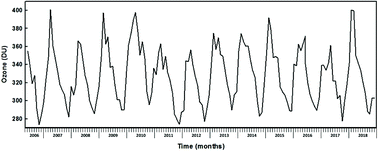当前位置:
X-MOL 学术
›
Photochem. Photobiol. Sci.
›
论文详情
Our official English website, www.x-mol.net, welcomes your
feedback! (Note: you will need to create a separate account there.)
Association between solar ultraviolet doses and vitamin D clinical routine data in European mid-latitude population between 2006 and 2018†
Photochemical & Photobiological Sciences ( IF 2.7 ) Pub Date : 2019-09-16 , DOI: 10.1039/c9pp00372j Davide Ferrari 1, 2, 3, 4, 5 , Giovanni Lombardi 4, 6, 7, 8, 9 , Marta Strollo 4, 5, 8, 10 , Marina Pontillo 4, 5, 8, 10 , Andrea Motta 4, 5, 8, 10 , Massimo Locatelli 4, 5, 8, 10
Photochemical & Photobiological Sciences ( IF 2.7 ) Pub Date : 2019-09-16 , DOI: 10.1039/c9pp00372j Davide Ferrari 1, 2, 3, 4, 5 , Giovanni Lombardi 4, 6, 7, 8, 9 , Marta Strollo 4, 5, 8, 10 , Marina Pontillo 4, 5, 8, 10 , Andrea Motta 4, 5, 8, 10 , Massimo Locatelli 4, 5, 8, 10
Affiliation

|
The major source of vitamin D in humans is the ultraviolet radiation-dependent cutaneous synthesis of cholecalciferol; however, low vitamin D status is common in Europe even at mid-latitudes. The UV-radiation that reached the Earth's surface near Milan between May 2006 and December 2018 was retrieved from the TEMIS database and matched with the serum vitamin D levels measured in 30 400 people living in the same area. The results showed a high percentage of insufficient vitamin D levels (measured as 25-hydroxy-vitamin D) throughout the years. During the “vitamin D winter” (November–March) up to 60–90% of the population shows deficient/insufficient (<20–30 ng mL−1) levels of vitamin D and it is explained by the difficulty in obtaining the recommended UV vitamin D doses. In contrast, the warm season provides plenty of UV-radiation, but still 30–50% of the population shows deficient/insufficient vitamin D levels. The circannual vitamin D variations were less evident in the female groups which, in the cold season, show values higher than the corresponding male groups. An age group analysis explained this difference by the strongly recommended vitamin D intake for post-menopausal women. In conclusion, increasing the medical advice for vitamin D intake is strongly recommended to improve the vitamin D status at European mid-latitudes. Our findings suggest that UV availability alone cannot explain the vitamin D status of the population which instead is likely to be influenced by several other factors related to both the people's lifestyle and their personal characteristics. A desirable vitamin D range considering the time of the year and sun exposure, but also including factors not related to UV-radiation, would probably result in a more accurate diagnosis of the patients’ vitamin D status. Despite the relatively large time interval, no evident effects due to climate changes were observed in the vitamin D levels during the almost 13 years of analysis.
中文翻译:

2006年至2018年之间欧洲中纬度人群太阳紫外线剂量与维生素D临床常规数据之间的关联†
人体内维生素D的主要来源是胆钙化固醇的紫外线辐射依赖性皮肤合成。然而,即使在中纬度地区,低维生素D状态在欧洲也很普遍。从TEMIS数据库中检索了2006年5月至2018年12月之间到达米兰附近地球表面的紫外线辐射,并将其与同一地区30400人的血清维生素D水平进行了匹配。结果表明,多年来维生素D含量不足(以25-羟基维生素D衡量)的比例很高。在“维生素D冬季”(11月至3月)中,多达60-90%的人口表现出不足/不足(<20-30 ng mL -1)维生素D的水平,这是由于难以获得推荐的紫外线维生素D剂量而造成的。相反,温暖的季节可提供大量的紫外线辐射,但仍有30-50%的人口维生素D水平不足/不足。女性群体中维生素D的年度变化不那么明显,在寒冷季节,其值高于相应的男性群体。年龄组分析通过强烈建议绝经后妇女摄入维生素D来解释这种差异。总之,强烈建议增加有关维生素D摄入量的医学建议,以改善欧洲中纬度地区的维生素D状况。我们的研究结果表明,仅紫外线的吸收不能解释人群的维生素D状况,而维生素D的状况可能会受到与人们的生活方式及其个人特征有关的其他几个因素的影响。考虑一年中的时间和阳光照射的理想维生素D范围,但还包括与紫外线辐射无关的因素,可能会导致更准确地诊断患者的维生素D状况。尽管有相对较长的时间间隔,但在近13年的分析中,未观察到由于气候变化对维生素D含量产生的明显影响。可能会更准确地诊断患者的维生素D状况。尽管有相对较长的时间间隔,但在近13年的分析中,未观察到由于气候变化对维生素D含量产生的明显影响。可能会更准确地诊断患者的维生素D状况。尽管有相对较长的时间间隔,但在近13年的分析中,未观察到由于气候变化对维生素D含量产生的明显影响。
更新日期:2019-11-06
中文翻译:

2006年至2018年之间欧洲中纬度人群太阳紫外线剂量与维生素D临床常规数据之间的关联†
人体内维生素D的主要来源是胆钙化固醇的紫外线辐射依赖性皮肤合成。然而,即使在中纬度地区,低维生素D状态在欧洲也很普遍。从TEMIS数据库中检索了2006年5月至2018年12月之间到达米兰附近地球表面的紫外线辐射,并将其与同一地区30400人的血清维生素D水平进行了匹配。结果表明,多年来维生素D含量不足(以25-羟基维生素D衡量)的比例很高。在“维生素D冬季”(11月至3月)中,多达60-90%的人口表现出不足/不足(<20-30 ng mL -1)维生素D的水平,这是由于难以获得推荐的紫外线维生素D剂量而造成的。相反,温暖的季节可提供大量的紫外线辐射,但仍有30-50%的人口维生素D水平不足/不足。女性群体中维生素D的年度变化不那么明显,在寒冷季节,其值高于相应的男性群体。年龄组分析通过强烈建议绝经后妇女摄入维生素D来解释这种差异。总之,强烈建议增加有关维生素D摄入量的医学建议,以改善欧洲中纬度地区的维生素D状况。我们的研究结果表明,仅紫外线的吸收不能解释人群的维生素D状况,而维生素D的状况可能会受到与人们的生活方式及其个人特征有关的其他几个因素的影响。考虑一年中的时间和阳光照射的理想维生素D范围,但还包括与紫外线辐射无关的因素,可能会导致更准确地诊断患者的维生素D状况。尽管有相对较长的时间间隔,但在近13年的分析中,未观察到由于气候变化对维生素D含量产生的明显影响。可能会更准确地诊断患者的维生素D状况。尽管有相对较长的时间间隔,但在近13年的分析中,未观察到由于气候变化对维生素D含量产生的明显影响。可能会更准确地诊断患者的维生素D状况。尽管有相对较长的时间间隔,但在近13年的分析中,未观察到由于气候变化对维生素D含量产生的明显影响。











































 京公网安备 11010802027423号
京公网安备 11010802027423号